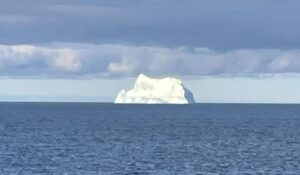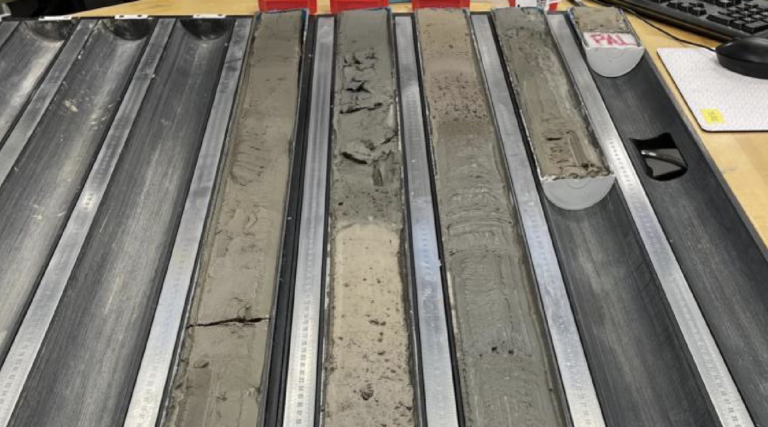The Institute of Arctic and Alpine Research (INSTAAR) at the University of Colorado has studied 25-million-year-old ocean sediment in Greenland’s ice sheet to understand how it has changed through the planet’s various warming and cooling cycles.

On board a ship off the icy coast of Greenland, Anne Jennings and the crew paid close attention to Fred, a massive, jagged iceberg. “It’s really beautiful and peaceful, but we don’t want it to get too close to our ship,” said Jennings, during a Zoom call from the ship. Jennings, a senior research associate at INSTAAR, is the co-chief scientist of an ocean-core drilling expedition in Baffin Bay, off the island’s northwest shore.
Fred, as she and the crew call it, is the 41st iceberg they’ve been tracking since they embarked two months ago. Some drifted too close, forcing the team to abandon their drilling sites and sail away. Despite this, the trip has been productive.
She and the 116-person crew boarded the JOIDES Resolution (JR), a 143m-long research ship on August 13, 2023, for the International Ocean Discovery Program’s (IODP) Expedition 400: Northwest Greenland Glaciated Margin. They set off to recover sediments tens of millions of years old from 965m below the sea floor to gain insights into how the Greenland ice sheet – one of two remaining ice sheets on Earth and the only one in the northern hemisphere – has changed through the planet’s various warming and cooling cycles.
“We are coring back into interglacial periods that were much warmer and had much higher atmospheric CO2 than today. And we’re also coring into time periods when the atmospheric CO2 level was similar to today’s,” Jennings said. By reconstructing the ice sheet conditions back then, Jennings and other paleoclimate scientists can make better predictions of what scenarios humans may face in the future.
Over hundreds of thousands of years, ice sheets – essentially very large glaciers – repeatedly covered large areas of Asia, Europe and North America, and melted away. About 11,500 years ago, gradual changes in Earth’s orbit enabled more sunlight to hit the northern hemisphere. As a result, Earth warmed up, marking the end of the last ice age and the beginning of what is known as the Holocene, the interglacial period that Earth is currently in.
“It’s of interest that all these other ice sheets in the northern hemisphere are gone, but the Greenland ice sheet is still here,” said Jennings, who studies ancient climate and ocean conditions.
As human-caused climate change drives up Earth’s temperature, scientists have observed that the Greenland ice sheet is melting, and the melting area is growing larger, affecting even high elevations. That’s concerning because it holds a large amount of fresh water. If the entire ice sheet melted, the global sea level could rise by 7.3m.
Jennings wants to know if similar melting occurred during the past interglacial periods when Earth was warm, and if the Greenland ice sheet had ever entirely melted. This could offer important clues in predicting its melting patterns in the current warming world.
Coring the ocean bed
To answer these questions, Jennings and two dozen scientists use a long drill that can pierce the ocean floor and retrieve sediments from over 800m beneath the ocean floor. The recovered cores contain rocks, sediments and fossils that have been there for millions of years, revealing a plethora of information that will help scientists understand ancient climates and ice sheet conditions.
Although the ice sheet may appear static, it is constantly moving, flowing downhill and outward toward the ocean, she explained. These icy rivers carve up the land, breaking and trapping rocks and sand within. The edge of these large glaciers sometimes breaks off into icebergs like Fred, which drift in the ocean and drop the trapped deposits to the seafloor as they melt.

Jennings and her team are looking for these deposits, which are telltale signs of ice in the ocean. By locating them in different layers of the sediments formed during different periods, the team can reconstruct how the ice sheet has changed over time. Frequently, paleontologists also find fossils of small plants and animals buried in the sediments, which offer important information about what past environments were like too.
So far, the team has extracted more than 400 cores at various sites throughout their two-month voyage. The drill pulls up a 9.7m-long core each time and returns to the same hole to drill deeper. The oldest and deepest sediments they have been able to retrieve during this expedition may be as much as 20 or 25 million years old, Jennings said.
All the cores from Expedition 400 are to be stored in a repository in Bremen, Germany. Scientists who plan further study on the cores, including Jennings, will convene next spring for a ‘sample party’ to take small samples from the repository to their labs all over the world.
After nearly four decades of scientific ocean drilling during over 200 scientific research expeditions, the JR, funded by the US National Science Foundation, will complete its final year of operations in 2024.
“Hopefully there will be support for a new generation of scientific ocean drilling research that will allow us to continue exploration and build on the extraordinary scientific legacy of the JR and IODP,” Jennings said.
For more key polar weather updates from the meteorological technology industry, click here.



